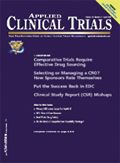Comprehensive Feasibility?
Applied Clinical Trials
Developing and utilizing a comprehensive feasibility strategy to avoid risk and ensure the most efficient clinical trial.
Yes, we need one...Clinical trial programs that commonly face unexpected delays and challenges are those that do not have a robust contingency plan and thus struggle to negotiate them in a timely fashion. A robust contingency plan will be incomplete if the outcomes from a well laid out comprehensive feasibility strategy does not form a part of it. So, developing and executing a comprehensive feasibility strategy is a vital step in the drug development life cycle, as it will not only enable the clinical developers to identify the risks but also recommend risk mitigation strategies very early on in the process.

Uma Arumugam, MD
Why?
Developing and incorporating a comprehensive feasibility strategy into the clinical development plan along with adequate allocation of time, budget, and resources is crucial for the success of a trial. This is more relevant and critical given the nature and complexity of trials in the current competitive landscape, especially for global programs.
This could be one of the defining criteria for the successful execution of a clinical trial program. It will enable clinical scientists and program managers to identify foreseen and unforeseen risks and develop strategies to mitigate them.
Time and resources
Subsequent to the development of a feasibility strategy, undertaking a successful feasibility exercise prior to the launch of a clinical trial or program is vital. Doing so provides an opportunity to address some of the critical unanswered or unvalidated questions that otherwise might not be addressed.
It is important that adequate budget, timelines, and resources are devoted to the strategy so that clinical teams have time to utilize the resultant information and effect changes either in their program or the study protocol.
The feasibility strategy should also anticipate potential changes, some of which may have a major impact, including on the design of the protocol.
Thus, a comprehensive feasibility strategy conducted within a realistic and executable period of time that employs appropriate resources, can make all the difference in a clinical trial.
Collaborative input
Developing a comprehensive feasibility strategy should be a collaborative exercise between the clinical and feasibility teams. Utmost care should be applied during development to make sure it addresses all key objectives of the program.
The feasibility teams, with support from their clinical and cross-functional colleagues, should be able to generate a comprehensive strategy to address potential foreseen and unforeseen risks. Given the elaborate and extensive nature of these exercises, input from other functional teams such as medical, regulatory, and reimbursement is also critical and should be included as part of the overall feasibility strategy.
Investing in this type of feasibility strategy will not only serve as a potential indicator of the viability of the clinical program, it will also be complementary to the contingency plan.
Developing and integrating a comprehensive feasibility strategy into the clinical development plan provides a great opportunity. Potential risks can be perceived and specific mitigation strategies developed well in advance. It's all about being proactive, not reactive.
Uma Arumugam, MD Head of Feasibility, North America Global Access to Patients Quintiles ua_808@yahoo.com

Managing Medical Devices in Digital Trials: Q&A With Flo Mowlem of ObvioHealth
April 10th 2024Following a webinar on the use of a medical device in a migraine clinical trial, Mowlem caught up with ACT to discuss her biggest takeaways and what she is currently seeing in the digital trials space.
An Examination of the Use of Patient Recruitment and Retention Tactics for Global Studies
March 18th 2024In light of scant published data from sponsors and contract research organizations on site activation and recruitment challenges following the COVID-19 pandemic, the primary objective of this research is to revisit the results of recruitment and retention tactics in studies conducted in 2012 and 2019.